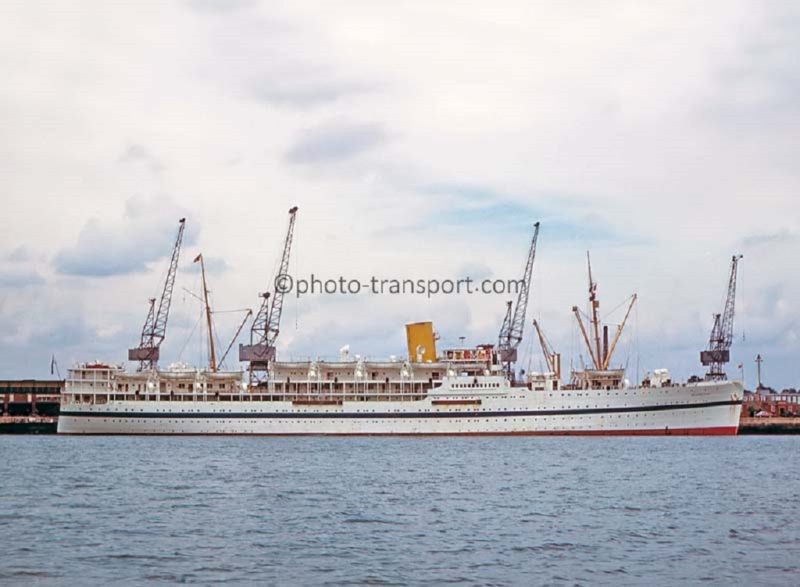
Devonshire was one of four similar ships built in the mid to late 1930s to carry to troops to and from the UK and the Middle and Far East, being chartered by their owners to the British Government. The ships were painted all white with a thick blue band around the hull, and a yellow funnel.
The first of the quartet, Dilwara made her maiden voyage in January 1936 and was built by Barclay Curle Co. Ltd., (Yard No 654) for the British India Steam Navigation Co. Ltd.
Serving with distinction throughout her career with British India, Dilwara was sold to China Navigation Co. of London, part of the John Swire Group, in September 1960. The vessel sailed for Hong Kong on the 7th October 1960. She was renamed Kuala Lumpur and was used in the pilgrim trade and cruising. The vessel left Sydney for the final time on the 20th September 1971 bound for Hong Kong via Singapore. The ship was laid up at Hong Kong before being sold to Taiwanese breakers where she arrived on 1st December. Her demolition commencing on the 1st April 1972 by Tung Cheng Steel Co. at Kaohsiung.
Barclay Curle Co. Ltd. completed Dunera (Yard No 663) for the British India S.N. Co. Ltd. in 1938. The ship remained with British India throughout her service and following a refit at Palmers, Hebburn on the Tyne, was converted to an Educational Cruise Ship departing on her first 14 day cruise in April 1961. Dunera arrived at Bilbao in Spain on the 9th November 1967 to be broken up by Revalorizacion de Materiales.
Ettrick, was completed in December 1938 by Barclay Curle Co. Ltd. (Yard No 669) for the Peninsular and Oriental Steam Ship Company.
Ettrick, whilst on the homeward journey from North Africa to Southampton, in convoy MKF1Y, was torpedoed and sunk by German U-Boat U-155 at 0315 hours on the 15th November 1942. The ship was about 150 miles west of Gibraltar and sank at about 0836 hours the same day with the loss of 24 crewmembers. Fortunately at the time she was not carrying any troops. The Norwegian manned Hunt Class destroyer HNoMS Glaisdale (L44) picked up the survivors.
U-155 sank another one of the escorts, the escort carrier HMS Avenger, in the same attack. A single torpedo hit the ship abreast a magazine causing it to explode. The ship sank in less than five minutes, with only 17 survivors form the crew of over 550.
Surviving the war U-155 was surrendered at Wilhelmshaven in May 1945, and subsequently sunk in Operation Deadlight, the scuttling of surrendered U-Boats in the North Atlantic in December 1945.
Devonshire was built by the Fairfield Shipbuilding & Engineering Co. Ltd. at Govan, (Yard No 670) being launched on the 20th December 1938 and completed in July 1939.
Devonshire was the final ship of the quartet and had a gross tonnage of 11,275, an overall length of 516’10” a beam of 63’ 3” and a draught of 24’ 8”. Two 8 cylinder Sulzer Winterhur diesels producing a maximum, of 6,300 bhp driving twin screws gave her a maximum speed of 16 knots, cruising speed was 14 knots.
As built the ship had accommodation for 104 first class passengers, 90 second class passengers and 1,150 troops who slept in dormitories/hammocks.
The first voyage undertaken by Devonshire was a short shake down cruise in July 1939 with her maiden troopship to India departing from Southampton on the 11th August 1939. The ship reached Gibraltar on the 6th September 1939 and after passing through the Suez Canal she arrived at Bombay on the 24th September 1939. Devonshire then returned to Gibraltar arriving there on the 27th October 1939 having sailed from Bombay on the 11th October 1939.
The next six months were spent in the Mediterranean, sailing between Gibraltar, Marseilles, Malta, Alexandria and Haifa. On the 25th May 1940 Devonshire sailed from Gibraltar for South Africa arriving at Durban on the 18th June 1940 taking on bunkers before sailing to Bombay, arriving there on the 20th October 1940.

A round trip to Singapore then took place, the vessel arriving back at Bombay on the 20th November 1940, where she remained until the 5th January 1941, carrying out a round trip to Haifa. The ship returned to Bombay on the 28th February 1941.
During March and April 1941 calls were made at Penang, Singapore and Madras arriving back at Bombay on the 25th April 1941. Several sailings were made to Basra, Karachi, Massawa and Suez on the 27th August 1941. From 25th September 1941 to 9th December 1941 four round trips were made between Bombay and Basra.
Devonshire undertook two trips to Singapore, departing from Bombay on the 21st December 1941 and 23rd January 1942 arriving at Singapore on 3rd January and 4th February 1942 respectively. The second trip was at the time of the imminent occupation of Singapore by the Japanese on the 15th February. The battle taking place from the 8th to 15th February 1942. Devonshire sailed quickly back to Bombay where she arrived on the 18th February 1942.
The ship then undertook a period of dry-docking at Bombay where repairs were carried out. The next four months were taken up with sailing to Basra, Karachi, Colombo, Aden, Suez, and Massawa before returning to Bombay on the 22nd June 1942.
Sailing for Sydney on the 25th June 1942, Devonshire arrived at the Australian port on the 12th August 1942, where she spent eleven days. A lengthy journey to Suez was then undertaken where she arrived on the 8th October 1942. For the remainder of 1942 the ship was visiting Indian Ocean ports with Christmas and New Year at Durban, South Africa.
Leaving Durban on the 9th January 1943, Devonshire spent four months in the Indian Ocean, calling at Beira, Kilindini, Aden and Bombay where she arrived on the 26th April 1943. Remaining in port in Bombay until sailing on the 8th April 1943 for Aden, arriving there on the 16th May and Suez on the 21st May 1943.
Whilst at Suez the vessel spent seven weeks being fitted out as a Landing Ship (Infantry) with landing craft slung from davits along her sides.
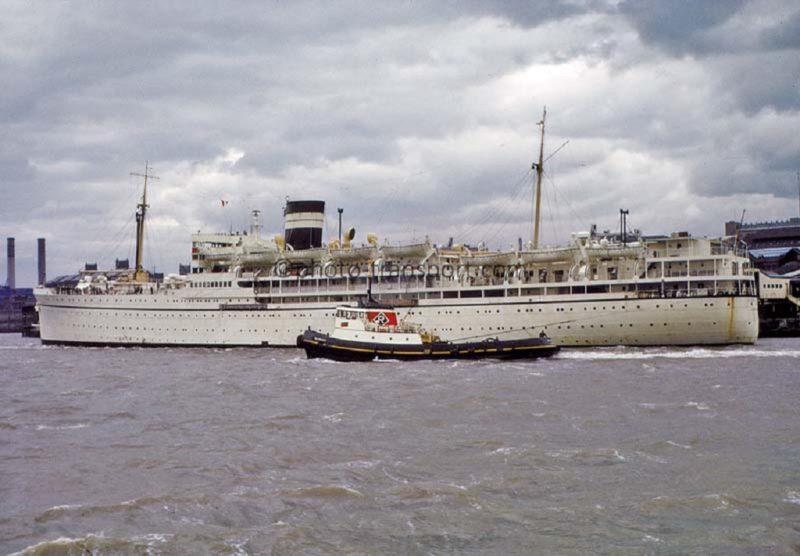
Forty-four troopships and former armed merchant cruisers including her near sisters Dilwara and Dunera were similarly fitted out. It had also been planned to refit Ettrick as an LSI had she not been lost in November 1942.
The ships were temporarily fitted out as LSIs but remained mercantile manned and operated by the Ministry of War Transport. The Royal Navy, of course, had the heavy cruiser HMS Devonshire in service, which at the time was under refit in the UK.
Devonshire entered the Mediterranean for the first time in three years, as part of Convoy MWF 36 from Port Said to Sicily. She took on the role as Command Operation Ship during Operation Husky the Allied invasion of Sicily from 10th July to 16th July 1943. The vessel also took part in Operation Baytown (Avalanche) the Allied invasion at Salerno 9th to 13th September 1943.
On the 8th November 1943 Devonshire sailed from Taranto in Italy for Bombay, arriving there on the 27th November 1943. A return trip to Taranto was made, the ship arriving at the Italian port on 22nd February 1944.
In March 1944 Devonshire was in the Mediterranean departing for Port Said on the 4th April 1944, arriving at Liverpool on the 21st April 1944. Three weeks were spent in the Mersey, before she moved to Methil on the east coast of Scotland thence back down the North Sea to Tilbury.
On the 6th June 1944 (D-day) Devonshire sailed for Juno Beach at Normandy, where, after discharging troops she returned to the Solent the following day. Further troops were landed at Seine Bay on the 8th June 1944 and again on the 30th June, from Southend.
The vessel retuned to Liverpool on the 6th September 1944, and sailed up to the Clyde from where she departed on the 20th October 1944, sailing to Bombay via Suez, where she arrived on the 29th November 1944.
For the rest of 1944 and all of 1945 Devonshire spent in the Red Sea and Indian Ocean. Port visits for the first time were, Kyaukpyu, Rangoon, Chittagong and Port Swettenham.
On VJ Day, Devonshire was in the Rangoon area, Operation Zipper the invasion of Malaya took place from 9th September to 19th September 1945 and involved Devonshire. The last quarter of that year saw the ship shuttling between Rangoon, Singapore and Colombo sailing from that final port on the 23rd December for Aden.
After the war Devonshire continued on her trooping duties to and from the Far East, and in July 1947 repatriated 1,000 Japanese prisoners of war from Singapore to Japan.
In February 1951 Devonshire was sailing from the UK to Gibraltar, when she encountered a gale in the Bay of Biscay. A spare piston rod broke loose, and the engines were put out of action. The ship broached to and experienced rolling of up to 45 degrees before power was restored.
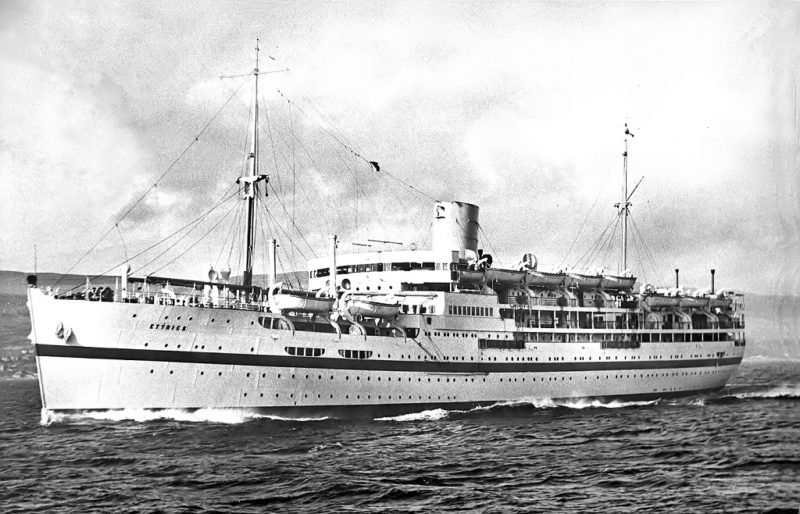

On the 1st August 1951 Devonshire sailed from the UK to the Far East, being delayed near the Suez Canal due to tensions in the area. Troops onboard included 12th Royal Lancers to Singapore and a battalion of the Royal Northumberland Fusiliers headed for the Korean War by way of Singapore, Hong Kong, Pusan and finally, Kure in Japan.
In February 1952 the ship was loaned to the Australian Government and assisted in the transportation of Australian troops who were being withdrawn from the occupation of Japan. Arriving on the 25th February 1952 from Japan, she sailed on the 3rd March with Australian troops for Korea. Prior to sailing it was necessary to carry out an extensive search of the ship as it was suspected that Communist sympathisers might have planted explosives onboard. The ship arrived at Kure on the 18th March 1952.
In September 1952 Devonshire arrived back in the UK and in April 1953 her builders, Fairfield S.B. and Engineering Co. on the Clyde, refitted her. The troop accommodation, consisting of the provision of hammocks for sleeping, was replaced by metal bunks and a cafeteria catering system was provided. As a consequence her troop carrying capacity was reduced to 824. First class accommodation was now for 130, 96 second class and 99 third class, plus the troop accommodation. Openings in her hull just aft of the forecastle were plated in.
During the Suez crisis of 1956 (Operation Musketeer) eight troopships were used including her two British India near sisters, Dilwara and Dunera, however Devonshire was not a participant.
In 1957 her homeport was changed from Liverpool to Southampton, and in July of that year British troopships were once again allowed to transit the Suez Canal following the crisis. Devonshire entered on the 30th July carrying troops from Jordan back to the UK.
In 1960 the decision was taken that future troop movements were to be carried out by air and the contract, which still had seven years to run, was ended. As a result the four troopships charted to the British Government were redundant. Nevasa and Dunera (BI), Oxfordshire and Devonshire (Bibby).
The idea of educational cruise ships was not new, and in the 1930s British India employed four of their troopships, Neuralia (9,812grt/1912), Nevasa (9,071grt/1912), Dunera and Dilwara, to take school boys on short cruises in the eight weeks of the summer holidays. With a more sinister motive of indoctrination into Fascist/Nazi ideals, Germany built the liner Wilhelm Gustloff (25,484grt/1938). The ship took workers on cruises in the “Strength Through Joy” Programme. The ship was sunk in the Baltic, evacuating civilians and troops, on the 30th January 1945 after being torpedoed by the Soviet submarine S-13 with a heavy loss of life, belived to be over 9,000 people making it the biggest loss of life in maritime history.
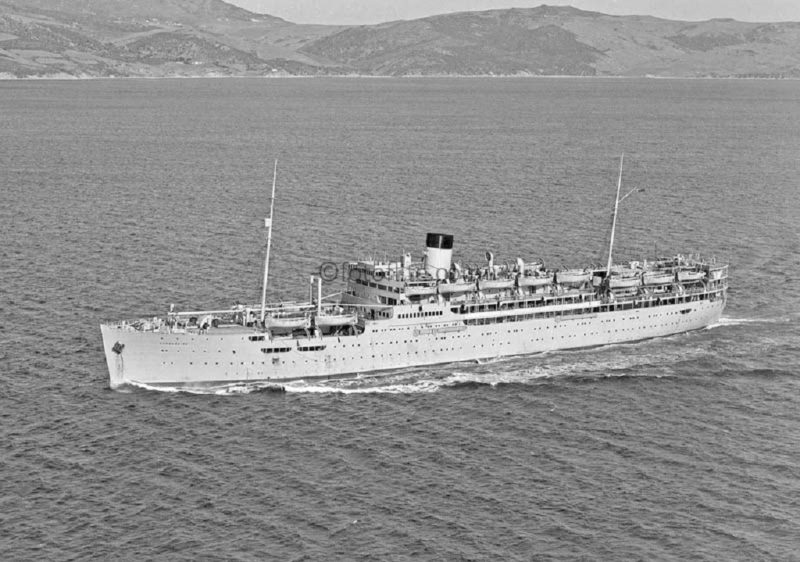
When British India was informed that it was proposed to cease troopship operations, the general manager of the trooping department, John Sharpe, made a proposal to convert Dunera into a permanent school ship.
Invitations were sent out to every Education Authority in Britain, and eventually the proposal was given the go ahead. Dunera underwent conversion at Palmers Yard at Hebburn on Tyneside and early in 1961 the first educational cruise sailed out of Greenock.
The educational cruises on Dunera were a success, and on the 17th January 1962 British India purchased Devonshire from Bibby Line for £175,000 and renamed her Devonia. The ship underwent a conversion by Barclay, Curle at Whiteinch, Glasgow, and entered service at Easter 1962. When entering service with British India she now had a gross tonnage of 12,795 tons with a service speed of 13.5 knots.
Following her refit Devonia had 37 dormitories with male pupils at the bow and females towards the stern. There was a 400 seat assembly hall with stage and cinema screen, plus a recreation room, cafeteria, reading room, tuck shop, games room and photographic developing room. The ship was also equipped with a surgery and hospital, plus a heated swimming pool.
Cabin class passengers, including accompanying teachers, had entirely separate accommodation with their own sun and recreation decks, public rooms, bars and dining saloon. Lectures, entertainment and shore excursions could be shared.
Her accommodation consisted of 194 cabin passengers and 834 dormitory students.
The two educational cruise ships normally sailed to ports in the Baltic, Scandinavia, Iberian Peninsular, Mediterranean, North Africa and the Canary Islands. On cruises to the Baltic and Scandinavia, St. Petersburg (Leningrad) was a particularly interesting port, especially at the height of the Cold War. Students were warmly welcomed and tours included the magnificent Hermitage Museum.
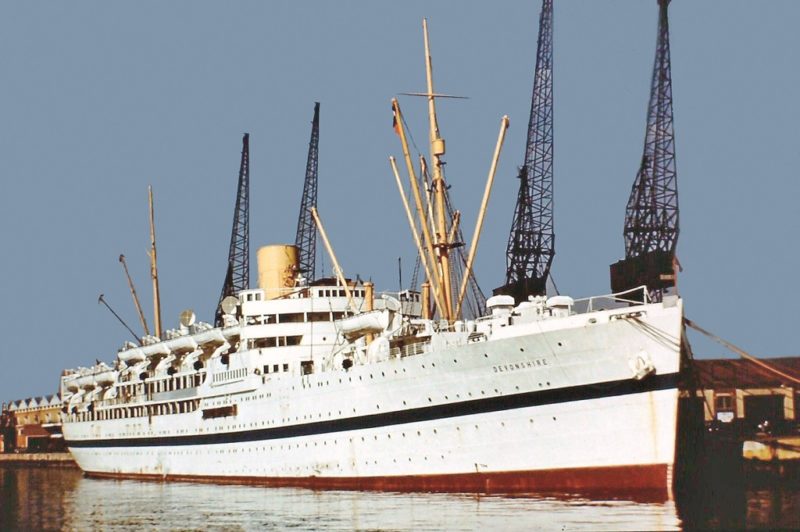
Especially selected Soviet students provided entertainment onboard, and were allowed to mingle with their British counterparts, usually speaking perfect English. Other regular Scandinavian/Baltic ports included, Copenhagen, Stockholm, Helsinki and Hamburg. The southern route included Spanish and Portuguese ports on the Atlantic coast, Gibraltar and Spanish Mediterranean ports. On occasions cruises commenced at Venice, passengers/students travelling there by ferry/rail from the UK. Other ports include North Africa, Malta, Greece and Tenerife.
The writer was a pupil onboard Devonia in May 1967 when the ship sailed from Corporation Quay, Sunderland to Gibraltar. Calls were made at Lisbon, Vigo and A Coruña. When sailing south through the Bay of Biscay the ship passed Dunera sailing north.
Highlights included swimming in the sea at Gibraltar and bartering with the street traders. I bought a watch for £1.10s.0d (£1.50) that stopped immediately I set foot back on UK soil. RAF and Fleet Air jets flew over ‘The Rock’ regularly as tensions with Spain were quite high at the time. The carriers HMS Hermes and HMS Victorious were in the Mediterranean but remained over the horizon.
A football match between pupils from the ship (nominated by teachers) and a Spanish school took place in one of the Spanish ports of call. Devonia lost 3–2. An inter-dormitory five a side football competition took place on one of the beaches, which stirred up a good deal of passion between the students. Unfortunately it also stirred up the passions of some of the local adolescent males and teachers from the ship had to warn them off the female pupils who were spectating and clad in relevant attire to cope with the heat.
Lifeboat drills took place every other day at sea and the crew appeared to take delight in punching upward on the lifebelt to ensure it was securely fastened. A slack lifebelt result in a sharp jar to the bottom of the jaw!
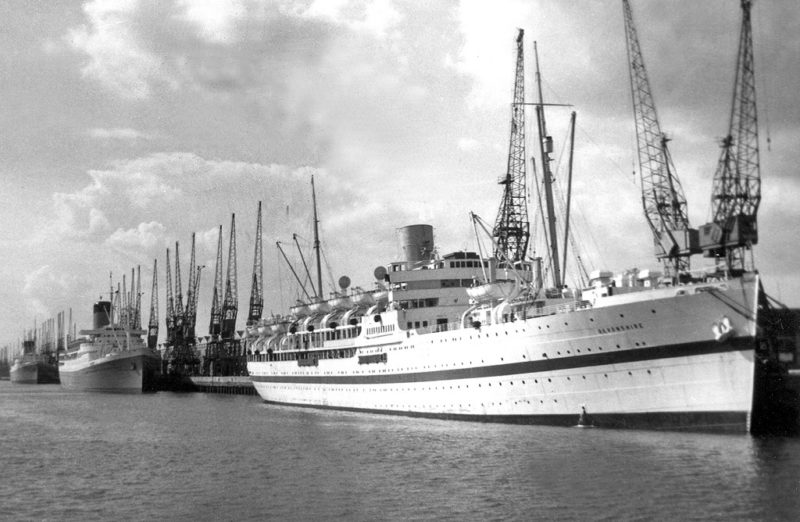
On one occasion the lifeboats were lowered and races between the various dormitories took place. The lifeboats were propelled by moving vertical poles backwards and forwards. These were attached to a gearing system, which turned the propeller. After several races it was apparent that one particular lifeboat was noticeably faster and I spotted a steward running a ‘sweep’ with some of the cabin passengers.
Another highlight, in the cafeteria, was the serving of a real Indian curry, which was far better than the usual weak variety that formed part of school lunches, or eaten at home. Indian restaurants and take aways had yet to become popular in the mainly rural area where we lived.
Whilst on the cruise it was apparent that many of the crew were disappointed that both Dunera and Devonia were to be withdrawn from service later that year. The much larger, former troopship, Nevasa (20,527grt/1956) had also been converted into an educational cruise ship and served in that role from October 1965. From 28th October 1965 and all of 1966 and up to December 1967 the three ships (Devonia, Dunera and Nevasa) operated educational cruises.
Rising fuel costs in the early/mid 1970s caused Nevasa to be withdrawn at the beginning of 1975 and laid up at Malta. She was broken up by Nan Feng Steel Enterprises at Kaohsiung arriving there on the 2nd April.
The B I liner Uganda (14,430 grt/1952) was withdrawn from the UK–East Africa route in 1967 and converted into an education cruise ship by Howaldtswerke-Deutsche, Hamburg at a cost of £2.8 million, raising her gross tonnage to 16,907.
Once converted, she could carry 300 passengers in cabins and 920 pupils in dormitories, some converted from her former holds.
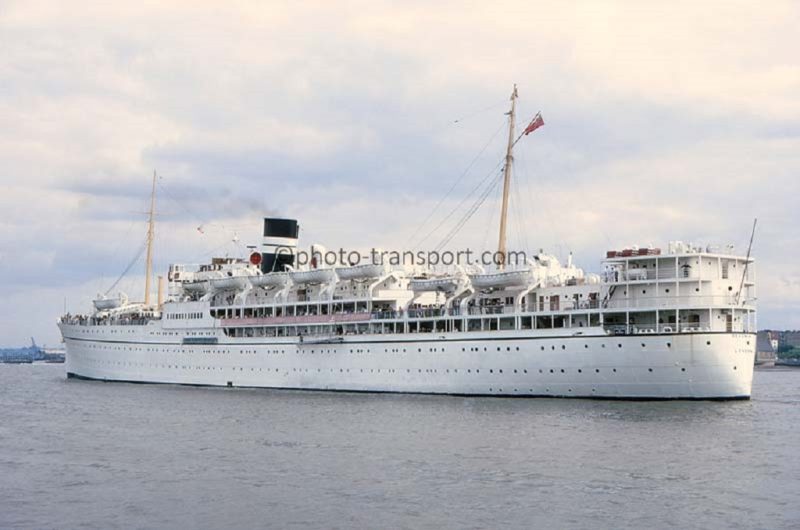
Uganda entered service on the 27th February 1968 and remained in the role for the next fourteen years until requisitioned and converted to a hospital ship for the Falklands conflict in 1982. Returning briefly to the role as an educational cruise ship September to November 1982, she was again chartered by the British Government to serve as a stores ship between Ascension Island and the Falkland Islands for the next two years. Laid up in the River Fal from the 4th May 1985, she was eventually renamed Triton for her final voyage to the breakers in 1986.
On the 22nd August 1986 Typhoon Wayne drove the ship ashore and ended up being beached at an angle of 70 degrees on her starboard side. She was eventually broken up six years later.
Devonia completed 110 educational cruises and on the 14th December 1967 the ship arrived at Cantieri Navali “Santa Maria”, La Spezia to be broken up.
Devonshire/Devonia served her owners and country well throughout her service without any major mishap. She carried many thousands of troops over hundreds of thousands of miles, took part in the invasions of Italy and France and, of course, was responsible for many happy memories for any school children undertaking cruises on the ship.
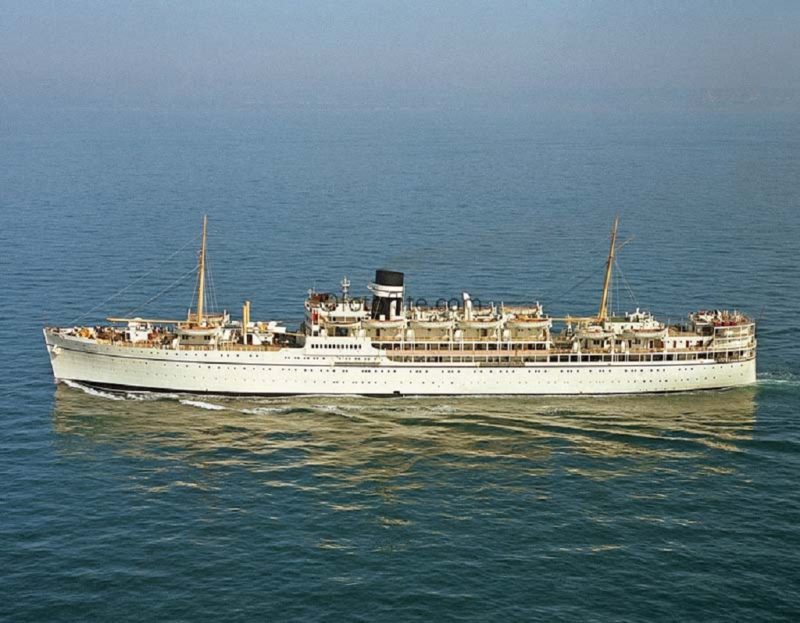
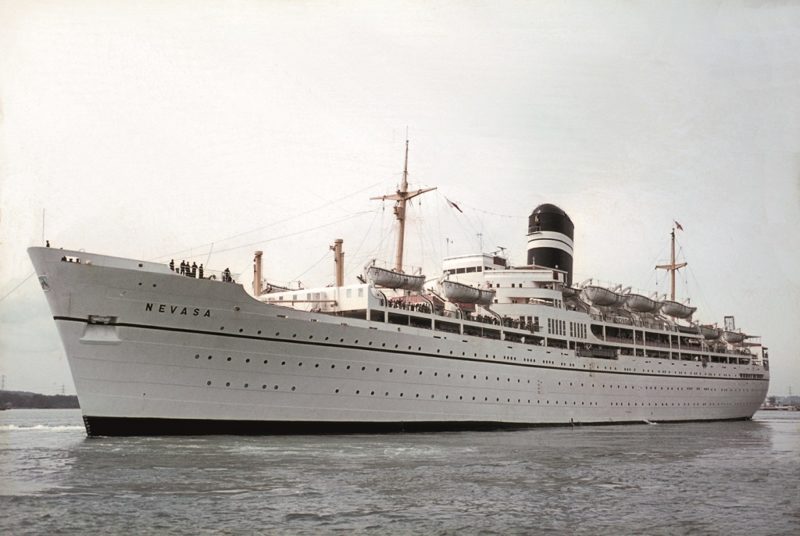





Comments
Sorry, comments are closed for this item